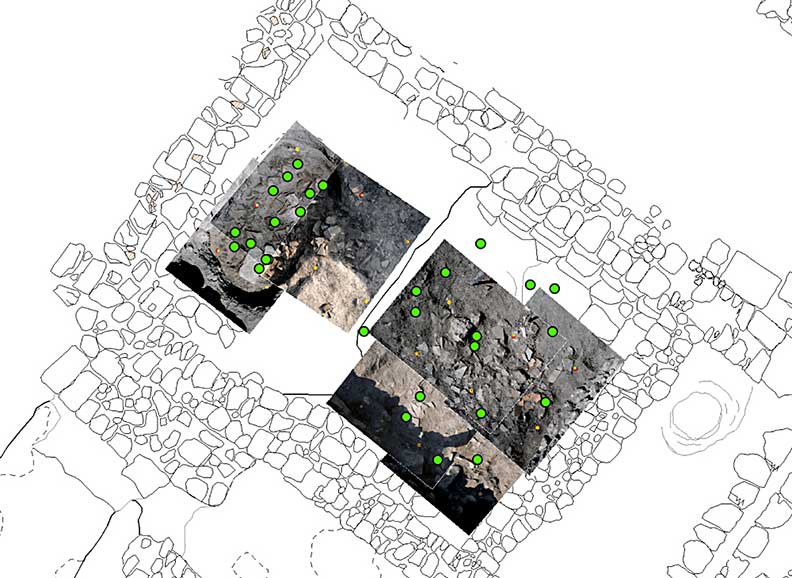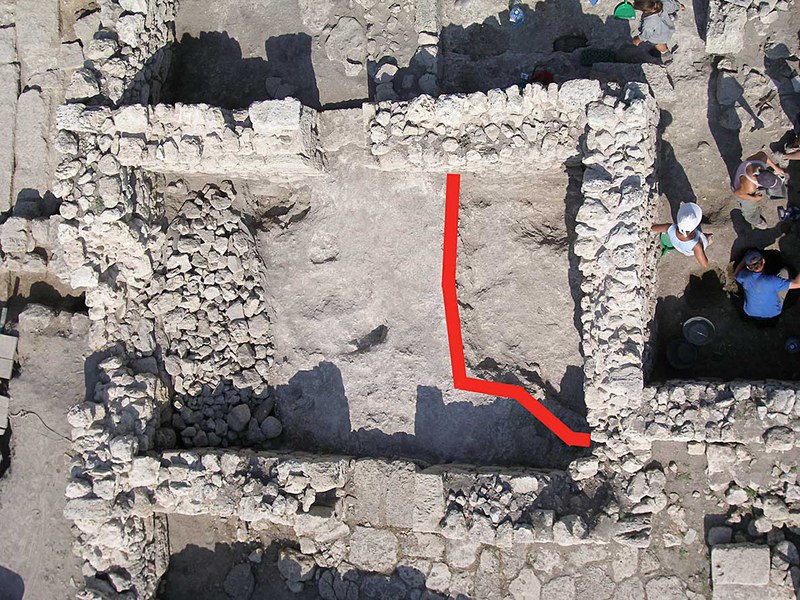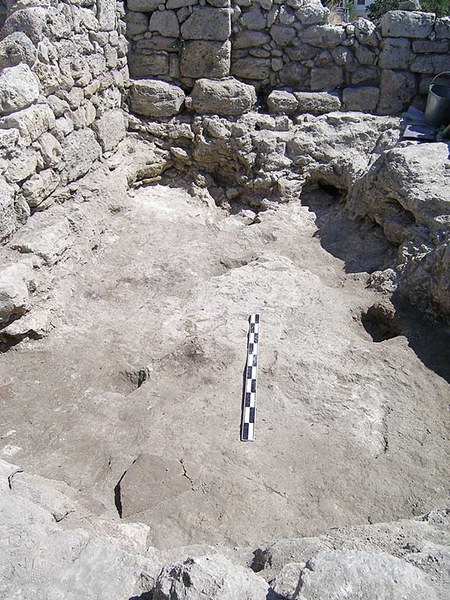
Our project "Buckets of Grain" is an attempt to apply scientific analyses to the rich collection of organic material discovered in and beneath the charred destruction layers of a late Byzantine residential block at Cherson (Chersonesos). The first stage of the project primarily involved the study of paleobotanical remains collected during the 2005 excavation campaign, although the Dumbarton Oaks project grant also helped to support the final stages of study of the large body of paleobotanical material recovered in 2004. In the field, our project involved an extensive program of random sampling, with bags of soil collected from surveyed points in use and destruction layers dated between the 10th and 13th centuries AD.
These samples then underwent flotation, during which the soil is immersed in water and lighter organic material is recovered in a series of sieves with increasingly fine screens. After the organic material had been collected from the sieves and sorted, Dr. Galina Pashkevich brought it back to the laboratory of the Institute of Archaeology of the Academy of Science of Ukraine, where she could study the seeds and plant fragments more carefully. In 2005 and early 2006, Dr. Pashkevich processed and studied more than 150 samples, most of which contained numerous plant remains. This work complements her study of the extensive material recovered in 2004, and the two bodies of material together are now helping us to understand patterns of production, trade, and consumption at Cherson in its middle and late Byzantine phases.
In 2004, we excavated the storeroom of what seems to have been a small grocer's shop of the 13th century (room 33). This room contained numerous pithoi and amphorae, some still holding their carbonized contents, as well as what seems to have been a wooden bucket or barrel and a large pile of charred grain. The results of the paleobotanical study in this room painted a vivid picture of both diet and commerce in late Byzantine Cherson: the bulk of the material consisted of bread wheat (triticum aestivum), though there were also a few olive pits (from imported olives, since the olive does not seem to have been cultivated in Crimea) and two grape pips found in a sample removed from the bottom of an amphora. The culinary picture was rounded out in the faunal record by a charred concretion found in one of the pithoi: it proved to contain the remains of tiny fish, perhaps either salted anchovies or sediment related to garos. The usefulness of our contextual recording system was then demonstrated by the comparison between samples from this area and samples taken from another storeroom in another part of the block. This second storeroom contained a much wider variety of grains (bread wheat, but also emmer, rye, spelt, and barley) than the first, as well as a proportionately larger quantity of pulses and legumes (peas and lentils). By contrast to the first storeroom, which contained bulk quantities of a few important staples, the remains in the second storeroom showed the wider variety and smaller volume one might expect for foodstuffs kept in a household pantry.

When the excavation season began in 2005, there was only one room left in the area of excavation that was entirely unexplored. It was a large room along the street, and we thought that it might contain remains as rich as those we had found in the other storerooms, both of which were located along the same side of the building. Yet sampling demonstrated that this room contained far less organic material than the others we have mentioned. The paleobotanical evidence included grains of barley, millet, and rye, as well as bread wheat and a few traces of fruits and nuts (grapes, figs, walnuts and hazelnuts). All of these remains, however, were present only in small quantities. At the north end of the room was a deep oval pit filled almost to floor level with soft brown soil. Around the edge of this pit were what appeared to be traces of charred wood or reeds with which it had been lined, and we assumed that the pit itself either contained a midden or served as a pen for a small domestic animal, perhaps a pig. The paleobotanical record, however, provided little support for either of these hypotheses. There were far fewer seeds, grains, and plant remains than one might have expected for a household midden or from an area where an animal was fed and lodged. The second idea is still a possibility, especially if the animal were fed from processed household scraps, as a pig might be, but it now seems more likely that the pit was used for cool storage.
As we began to investigate the levels below the floors of the 13th-century residential spaces, the paleobotanical record continued to play an important role in our interpretation of the remains. The latest buildings seem to have been erected at some point in the 12th century, in a massive and organized construction campaign that was preceded by the thorough removal of earlier structures. Our excavations revealed deep layers of fill below the final floors of several of the rooms we have discussed. Room 33, in particular, had been filled by more than a meter of earth, bones, and artifacts. The ceramics recovered from this fill ranged from the 6th–7th to the 12th centuries; this chronological spread, as well as the presence of very large quantities of animal bones, suggested that the fill had been hauled in from some large, long-lived urban midden. This impression is supported by comparison of the ceramic and faunal evidence with the paleobotanical material. The greatest majority of plant remains in this fill came from weeds and wild plants, some of which—like the elderberry (sambucus nigra)—prefer nitrogen-rich soils in open but uncultivated areas. The paleobotanical record too, then, points to a city dump as the origin of the leveling fill employed in the construction of these 12th-century buildings.

Much more interesting, if somewhat more ambiguous, is the paleobotanical evidence we recovered from the remains of the pre-12th-century occupation of the block. Under most of the rooms of the last phase were deep, fairly regular bedrock cuts that seem to indicate a series of subrectangular sunken-floor buildings. These cuts follow roughly the same alignment as the 12th-century block, and thus the same alignment as the original Greek orthogonal grid, but they do not correspond to the room or complex divisions of the later block. At the bottom of several of the cuts we investigated were preserved their final beaten-earth floor surfaces. Some of these were less informative than others. In the early floor under room 30, for example, the paleobotanical record included only a few grains of bread wheat. The same beaten-earth floor, on the other hand, provided perhaps a more vivid window into moments in the life of its middle Byzantine residents: a newborn baby or late-term fetus had been buried in a small hole in the floor in the corner of the room.
Room 33, again, provided much richer material for our program of paleobotanical research. On the surface of the beaten-earth floor of this bedrock cut were two small hearths, indicated only by concentrations of dark-brown ash and charcoal (figure 4). On an architectural level, these hearths supported the idea that we were dealing with sunken-floor buildings, rather than the basement levels of multi-storey constructions. On a paleobotanical level, we hoped that they would provide us with comparative evidence for diet and staple economy immediately prior to the 12th-century construction program. Although there is always the possibility that paleobotanical remains, like pottery, are residual and relate to earlier periods, the limited chronological horizon and relatively sealed context of a hearth feature makes it a more reliable measure of the time at which it was formed.
We were not disappointed. Although the numismatic evidence from this floor strongly suggests that the final use of the structure (and thus of these hearths) dates at the earliest to the 11th century, we were still able to recover earlier evidence for diet and daily life with which we can compare the more extensive 13th-century material. Both hearths contained a range and quantity of paleobotanical material that was striking in proportion to the small volume of the deposits themselves. The range of material, in particular, is informative: the wide variety of species represented confirms our impression that the household pantry was much more diverse than the few staples represented in the commercial phase of room 33.
One of the hearths was particularly rich. The largest portion of the paleobotanical evidence it produced consisted of grain, including barley, millet, Italian millet (setaria italica), rye, einkorn wheat, and emmer, in addition to bread wheat (although the latter still contributed the largest number of grains). It also contained the remains of lentils, hazelnuts, walnuts, and fig seeds, as well as an olive pit. Some inedible remains were also represented, mainly from weeds present in cultivated fields and grassy areas (e.g. galium aparine, the seeds of which are common intrusions among threshed cereal grains). Although the identifiable paleobotanical specimens in this hearth number only 75, we can draw several preliminary conclusions, especially since the deposit is likely to belong to a brief chronological horizon between the late 11th and early 12th centuries AD. First, the range of grains used shows that the diet at Chersonesos at this time, at least in this household, had more variety than literary sources might suggest—the predominance of bread wheat is far less marked than one might expect, for example, although this might also be explained by cooking practices (perhaps bread itself was baked elsewhere or purchased, while the grains here were used in porridges and stews). On the other hand, millet, usually deprecated as a foodstuff in the written sources, is well represented. Second, the presence of the olive pit indicates that traded staples from Asia Minor or the Mediterranean were available even to consumers of modest means in this period. As we mentioned above, it is generally believed that the olive was never cultivated in Crimea, and thus olive remains almost certainly indicate importation. Third, the variety of grains, the other examples of fruits and nuts, and the evidence for weeds from cultivated fields all tend to indicate active cultivation in the immediate area of Chersonesos in this period. This last point relates to one of the more interesting questions that our evidence raises, and one to which we hope to apply other research methods as well. Given the turmoil of the late 10th century at Chersonesos, and given the general instability of the area in the following centuries, it will be very interesting to examine agricultural patterns in the city's hinterland. Investigations at several Greek and Roman sites in the chora suggest a general abandonment of intensive agriculture after the Roman period, but as part of a separate project, we hope to supplement these impressions with a careful study of the palynological record in at least one soil core that contains a large medieval deposit.
Part of our program in the coming season involves the completion of the study of the paleobotanical remains; the publication of this sample material will, we think, be greatly aided by its integration into our GIS-based documentation system. Most of our research during the summer of 2006, however, will be focused on the better-preserved pieces of carbonized wood and wooden objects. The goal of this examination is a better understanding of the types of wood available at Chersonesos and the different purposes for which they were used, as well as knowledge of wood-working technologies and of the role of wood in late Byzantine architecture at Chersonesos.